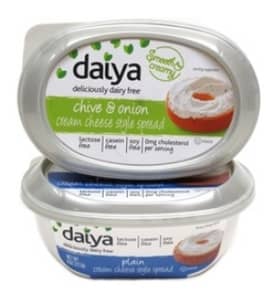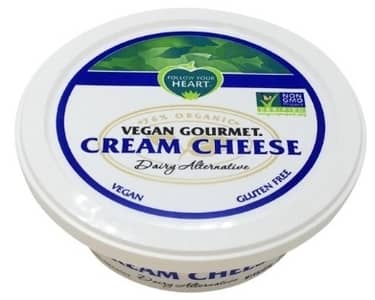Cream cheese is a fresh, mild-tasting, soft cheese that’s used as a spread, or as a base for numerous recipes and dishes, many being deserts and sweets.1
Cheesecake is probably the most iconic dessert using cream cheese as a primary ingredient. Stabilizers like carrageenan and carob bean gum are typically added in industrial production.2
Is cream cheese vegan? No, real cream cheese is never vegan. It’s made from milk and cream, both of which are dairy products, and thus derived from animals.
Is cheesecake vegan? No, real cheesecake is always non-vegan. And, while it’s true that much of the so-called “cheesecake” you’ll encounter in cafeterias and foodservice establishments don’t use actual cream cheese, they typically incorporate gelatin, which is also animal-derived.
What we’ll do here is get into the various reasons why cream cheese and cheesecake are considered off-limits for vegans, and then list any vegan-friendly alternatives on the market.
Why Cream Cheese Is Non-Vegan
Vegetarians avoid the consumption of meat (including red meat, seafood, and poultry), and try to avoid by-products derived from animal tissue.3,4
Veganism takes it a step further. It’s known as the strictest form of vegetarianism, and for good reason.
Veganism, is the practice of avoiding all animal products, particularly (though, not limited to) the diet.The philosophy rejects the commodity status of animals in all forms.5-7
The above definition applies to veganism in general. However, there are different subcategories of the eating pattern (eco, health, ethical, etc.). But, the common denominator is that they all avoid consuming animal products.
For example, dietary vegans, aka health vegans, refrain from consuming animal products, including meat, dairy, eggs, and other animal-derived substances (for example – honey, confectioner’s glaze, etc.).
Ethical vegans avoid consuming animals but take it even further by avoiding leather and fur, etc.
Environmental or eco-vegans, avoid animal products due to the environmental implications of their manufacturing and cultivation. For example, the industrial farming of animals has long been known to be environmentally damaging and unsustainable, due to deforestation and increased greenhouse gas emissions.8
But, whatever the motivation, all vegans share one thing in common: the avoidance of animal products including meat, eggs, and dairy.
Why Cheesecake Is Non-Vegan
As mentioned above, cheesecake is non-vegan due to presence of dairy (in the case of real cheesecake) or gelatin (cheap cafeteria-style imitation cheesecake).
In fact, cheesecake filling can be made with any number of animal products including:9
- Cream cheese
- Cottage cheese
- Eggs
- Butter
- Honey-containing graham cracker crust
The list goes on, but that will give you an idea.
Some cheesecake even contains a top layer of sour cream.9
In North America, it’s not uncommon to have heavy cream and extra egg yolks thrown in the mix, because these fat-laden animal products make for a richer, creamier, and denser cheesecake.9
In France, Neufchatel cheese (a soft mold-ripened cheese) and gelatin are preferred ingredients. In Japan, emulsified cornstarch along with eggs are used to create an extra smooth cheesecake.9
Don’t Some Vegans Consume Dairy?
I’d imagine most folks asking this question are probably referring to lacto-vegetarianism. To be clear, there is no such thing as a lacto-veganism.
A lacto-vegetarian diet is one that includes plant foods per usual, but also throws in dairy as a sole source of animal protein; lacto-ovo vegetarians allow dairy and eggs.10,11
While lacto-vegetarians consume milk, yogurt, cheese, ghee, butter, cream, and kefir to their heart’s content, vegans have to refrain from all dairy products. Full stop.
Commercial Vegan “Cream Cheese”
Any good vegan cream cheese replacement will be soft, whitish in color, mild-tasting, and have a high water content.
Cream cheese is a fresh cheese and has a water content of about 80%.12
The pH of the cream cheese determines its water-holding capacity, or WHC, and thus how much moisture it retains.13
Acid-coagulated cheeses having a high water content are mild and have less of a flavor profile. Other examples include cottage, ricotta, farmer’s, feta, and pot cheeses.12
Acid coagulation involves either adding an acid source directly to the milk or using a more complex method that entails inculcating the milk with starter cultures that then acidify the milk by converting lactose (the simple sugar in milk) to lactic acid or LA.14,15
This produces the soft and spongy texture characteristic of cream cheese.
Finally, the cheese replacement will need to be dull in flavor. Acid-coagulated cheeses like cream cheese aren’t typically aged, because the high acid content inhibits mold and bacterial growth, both of which characterize the aging process.16
So, what kind of plant substance is white, dull, and high in water content?
If you guessed tofu, then you are correct! Go with soft silken tofu. With a bit of blending, and perhaps a dash more water, it’ll be a perfect consistency.
Additionally, there are a few vegan cream cheese specialty products on the market.
Daiya Cream Cheeze Style Spread

Ingredients for the plain include filtered water, coconut oil/coconut cream, tapioca starch, non-GMO expeller pressed safflower oil, natural flavors (all vegan), pea protein isolate, cane sugar, sea salt, xanthan gum, guar and locust bean gums, potato protein isolate, vegan lactic acid, vegan enzyme, and lemon juice concentrate.17
Other flavors include strawberry, garden vegetable, and chive/onion—all of which are equally vegan-friendly.18-20
Follow Your Heart Dairy-Free Cream Cheese

I haven’t used this variety, but I do use their mayonnaise and sliced cheese, both of which are really good.
This one contains filtered water, organic coconut oil, corn starch, faba bean protein, organic vegan cane sugar, sea salt, modified potato starch, sugarcane fiber, additives (tricalcium phosphate, sodium citrate, and citric acid), natural plant-sourced flavors, xanthan gum, lactic acid (plant sources), and beta carotene (for color).21
That’s it for the vegan status of cream cheese and cheesecake. Thanks for reading.
You may also want to check out the following related articles:
References
- Cream-cheese Noun – Definition, Pictures, Pronunciation and Usage Notes: Oxford Advanced Learner’s Dictionary. https://www.oxfordlearnersdictionaries.com/us/definition/english/cream-cheese
- Cream Cheese. Bon Appetit – https://www.bonappetit.com/entertaining-style/article/cream-cheese
- What Is a Vegetarian: The Vegetarian Society. https://www.vegsoc.org/page.aspx?pid=508
- Why Avoid Hidden Animal Ingredients? https://navs-online.org/articles/why-avoid-hidden-animal-ingredients/
- Helena Pedersen, Vasile Staescu, “Conclusion: Future Directions for Critical Animal Studies”, in Nik Taylor, Richard Twine (eds.), The Rise of Critical Animal Studies: From the Margins to the Centre, Routledge, 2014 (262–276).
- Gary Steiner, Animals and the Limits of Postmodernism, Columbia University Press, 2013, 206
- Gary Francione, “Animal Welfare, Happy Meat and Veganism as the Moral Baseline”, in David M. Kaplan, The Philosophy of Food, University of California Press, 2012 (169–189) 182.
- Sea Shepherd’s Paul Watson: ‘you Don’t Watch Whales Die and Hold Signs and Do Nothing’ part Michael Shapiro for Earth Island Journal – https://www.theguardian.com/environment/2010/sep/21/sea-shepherd-paul-watson-whales
- Understanding Food: Principles and Preparation (Page 479). Amy Brown – Wadsworth Cengage Learning – 2011
- Spencer, Colin: The Heretic’s Feast. A History of Vegetarianism, London: Fourth Estate 1993, p. 69–84. ISBN 1-85702-078-2.
- Becoming a Vegetarian. Harvard Health Publishing – https://www.health.harvard.edu/staying-healthy/becoming-a-vegetarian
- Understanding Food: Principles and Preparation (Page 233). Amy Brown – Wadsworth Cengage Learning – 2011
- Gigante ML, M Almena-Almena, and PS Kindstedt. Eff ect of cheese pH and temperature on serum phase characteristics of cream cheese during storage. Journal of Food Science 62(1):53–56, 1997.
- Branger EB, et al. Sensory characteristics of cottage cheese whey and grapefruit juice blends and changes during processing. Journal of Food Science 64(1):180–184, 1999.
- Breidt F, and HP Fleming. Using lactic acid bacteria to improve the safety of minimally processed fruits and vegetables. Food Technology 51(9):44–48, 1997.
- Understanding Food: Principles and Preparation (Page 236). Amy Brown – Wadsworth Cengage Learning – 2011
- Plain Cream Cheeze Style Spread: Dairy-free Cream Cheese: Daiya. https://daiyafoods.com/our-foods/cream-cheese-style-spreads/plain/
- Strawberry Cream Cheeze Style Spread: Daiya. Deliciously-dairy Free. https://daiyafoods.com/our-foods/cream-cheese-style-spreads/strawberry/
- Chive & Onion Cream Cheeze Style Spread: Daiya. Deliciously Dairy-free. https://daiyafoods.com/our-foods/cream-cheese-style-spreads/chive-onion/
- Garden Vegetable Cream Cheeze Style Spread: Deliciously Dairy-free. https://daiyafoods.com/our-foods/cream-cheese-style-spreads/cream-cheese-style-spreadsgarden-vegetable/
- Dairy-free Cream Cheese. https://followyourheart.com/products/cream-cheese/

